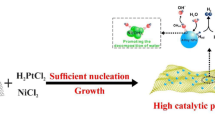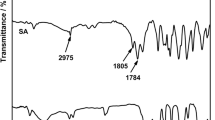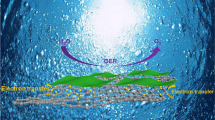Abstract
Design and engineering of efficient electrocatalysts toward hydrogen evolution reaction (HER) are essential in the development of renewable energy conversion and storage. Single atomic electrocatalysts (SACs), including platinum (Pt) SACs, play a key role in catalysis owing to the ~ 100% utilization of the desired atom thus minimizing the usage of noble metals. Herein, we show a facile method to atomically anchor Pt atoms on TiO2 nanosheets modified with graphene (Pt@TiO2/NSG with an ultralow Pt loading of 1.61 wt%). The atomic dispersion of Pt on TiO2/NSG structure was confirmed by aberration-corrected scanning transmission electron microscopy and was anchored by numerous surface functional groups on abundant exposed basal planes in TiO2/NSG heterostructure. Benefiting from the synergetic effect due to the interaction between active centers, Pt SACs, and the TiO2/NSG substrate, the Pt@TiO2/NSG electrocatalyst exhibited excellent electrocatalytic activity toward HER in an acidic electrolyte, with a low overpotential of 38 mV to reach 10 mA cm−2, a small Tafel slope of 40 mV/dec, and a decent durability for the 1000th cycles of HER polarization curve has only 1 mV shift, which is even better than those of commercial Pt/C benchmark electrocatalysts. This work supplies a strategy to realize the controllable development of Pt SACs with low cost, high activity, and long-term stability.





Similar content being viewed by others
References
Chu S, Cui Y, Liu N (2016) The path towards sustainable energy. Nat Mater 16:16. https://doi.org/10.1038/nmat4834
Valenti G, Boni A, Melchionna M et al (2016) Co-axial heterostructures integrating palladium/titanium dioxide with carbon nanotubes for efficient electrocatalytic hydrogen evolution. Nat Commun 7:13549. https://doi.org/10.1038/ncomms13549
Mahmood J, Li F, Jung SM et al (2017) An efficient and pH-universal ruthenium-based catalyst for the hydrogen evolution reaction. Nat Nanotechnol 12:441. https://doi.org/10.1038/nnano.2016.304
Zou X, Zhang Y (2015) Noble metal-free hydrogen evolution catalysts for water splitting. Chem Soc Rev 44:5148. https://doi.org/10.1039/c4cs00448e
Niether C, Faure S, Bordet A et al (2018) Improved water electrolysis using magnetic heating of FeC–Ni core–shell nanoparticles. Nat Energy 3:476. https://doi.org/10.1038/s41560-018-0132-1
Liu Y, Wu J, Hackenberg KP et al (2017) Self-optimizing, highly surface-active layered metal dichalcogenide catalysts for hydrogen evolution. Nat Energy. https://doi.org/10.1038/nenergy.2017.127
Chen C, Kang Y, Huo Z et al (2014) Highly crystalline multimetallic nanoframes with three-dimensional electrocatalytic surfaces. Science 343:1339. https://doi.org/10.1126/science.1249061
Seh ZW, Kibsgaard J, Dickens CF, Chorkendorff I, Norskov JK, Jaramillo TF (2017) Combining theory and experiment in electrocatalysis: insights into materials design. Science. https://doi.org/10.1126/science.aad4998
Chen S, Qiao SZ (2013) Hierarchically porous nitrogen-doped graphene-NiCo (2) O (4) hybrid paper as an advanced electrocatalytic water-splitting material. ACS Nano 7:10190. https://doi.org/10.1021/nn404444r
Greeley J, Jaramillo TF, Bonde J, Chorkendorff IB, Norskov JK (2006) Computational high-throughput screening of electrocatalytic materials for hydrogen evolution. Nat Mater 5:909. https://doi.org/10.1038/nmat1752
Deng D, Novoselov KS, Fu Q, Zheng N, Tian Z, Bao X (2016) Catalysis with two-dimensional materials and their heterostructures. Nat Nanotechnol 11:218. https://doi.org/10.1038/nnano.2015.340
Han S, Cai C, Yang F et al (2020) Interrogation of the reaction mechanism in a Na-O2 battery using in situ transmission electron microscopy. ACS Nano 14:3669. https://doi.org/10.1021/acsnano.0c00283
Qiao B, Wang A, Yang X et al (2011) Single-atom catalysis of CO oxidation using Pt1/FeOX. Nat Chem 3:634. https://doi.org/10.1038/nchem.1095
Peng Y, Hirata EY, Pan W, Chen L, Lu JE, Chen S (2018) Intraparticle charge delocalization through conjugated metal-ligand interfacial bonds: effects of metal d electrons. Chin J Chem Phys 31:433. https://doi.org/10.1063/1674-0068/31/cjcp1804073
You B, Sun Y (2018) Innovative strategies for electrocatalytic water splitting. Acc Chem Res 51:1571. https://doi.org/10.1021/acs.accounts.8b00002
Chen P, Tong Y, Wu C, **e Y (2018) Surface/interfacial engineering of inorganic low-dimensional electrode materials for electrocatalysis. Acc Chem Res 51:2857. https://doi.org/10.1021/acs.accounts.8b00266
Zhang J, Zhang Q, Feng X (2019) Support and interface effects in water-splitting electrocatalysts. Adv Mater 31:e1808167. https://doi.org/10.1002/adma.201808167
Li Z, Niu W, Yang Z et al (2020) Boosting alkaline hydrogen evolution: the dominating role of interior modification in surface electrocatalysis. Energy Environ Sci 13:3110. https://doi.org/10.1039/d0ee01750g
Yao Q, Huang B, Zhang N, Sun M, Shao Q, Huang X (2019) Channel-rich RuCu nanosheets for pH-universal overall water splitting electrocatalysis. Angew Chem Int Ed Engl 58:13983. https://doi.org/10.1002/anie.201908092
Zheng Y, Jiao Y, Zhu Y et al (2016) High electrocatalytic hydrogen evolution activity of an anomalous ruthenium catalyst. J Am Chem Soc 138:16174. https://doi.org/10.1021/jacs.6b11291
Qiu T, Liang Z, Guo W et al (2019) Highly exposed ruthenium-based electrocatalysts from bimetallic metal-organic frameworks for overall water splitting. Nano Energy 58:1. https://doi.org/10.1016/j.nanoen.2018.12.085
Zheng J (2017) Binary platinum alloy electrodes for hydrogen and oxygen evolutions by seawater splitting. Appl Surf Sci 413:72. https://doi.org/10.1016/j.apsusc.2017.04.016
Zhang J, Wang G, Liao Z et al (2017) Iridium nanoparticles anchored on 3D graphite foam as a bifunctional electrocatalyst for excellent overall water splitting in acidic solution. Nano Energy 40:27. https://doi.org/10.1016/j.nanoen.2017.07.054
Wu X, Feng B, Li W et al (2019) Metal-support interaction boosted electrocatalysis of ultrasmall iridium nanoparticles supported on nitrogen doped graphene for highly efficient water electrolysis in acidic and alkaline media. Nano Energy 62:117. https://doi.org/10.1016/j.nanoen.2019.05.034
You H, Wu D, Chen Z-n et al (2019) Highly active and stable water splitting in acidic media using a bifunctional iridium/cucurbit [6] uril catalyst. ACS Energy Lett 4:1301. https://doi.org/10.1021/acsenergylett.9b00553
Pi Y, Shao Q, Wang P, Guo J, Huang X (2017) General formation of monodisperse IrM (M = Ni Co, Fe) bimetallic nanoclusters as bifunctional electrocatalysts for acidic overall water splitting. Adv Func Mater. https://doi.org/10.1002/adfm.201700886
Sheng W, Gasteiger HA, Shao-Horn Y (2010) Hydrogen oxidation and evolution reaction kinetics on platinum: acid vs alkaline electrolytes. J Electrochem Soc. https://doi.org/10.1149/1.3483106
Cheng N, Stambula S, Wang D et al (2016) Platinum single-atom and cluster catalysis of the hydrogen evolution reaction. Nat Commun 7:13638. https://doi.org/10.1038/ncomms13638
Morales-Guio CG, Stern LA, Hu X (2014) Nanostructured hydrotreating catalysts for electrochemical hydrogen evolution. Chem Soc Rev 43:6555. https://doi.org/10.1039/c3cs60468c
Li K, Zhang J, Wu R, Yu Y, Zhang B (2016) Anchoring CoO domains on CoSe2 nanobelts as bifunctional electrocatalysts for overall water splitting in neutral media. Adv Sci (Weinh) 3:1500426. https://doi.org/10.1002/advs.201500426
Subbaraman R, Tripkovic D, Strmcnik D et al (2011) Enhancing hydrogen evolution activity in water splitting by tailoring Li (+)-Ni (OH) (2)-Pt interfaces. Science 334:1256. https://doi.org/10.1126/science.1211934
Bayatsarmadi B, Zheng Y, Vasileff A, Qiao SZ (2017) Recent advances in atomic metal do** of carbon-based nanomaterials for energy conversion. Small. https://doi.org/10.1002/smll.201700191
Jiao Y, Zheng Y, Jaroniec M, Qiao SZ (2015) Design of electrocatalysts for oxygen- and hydrogen-involving energy conversion reactions. Chem Soc Rev 44:2060. https://doi.org/10.1039/c4cs00470a
Nilsson A, Pettersson LGM, Hammer B, Bligaard T, Christensen CH, Nørskov JK (2005) The electronic structure effect in heterogeneous catalysis. Catal Lett 100:111. https://doi.org/10.1007/s10562-004-3434-9
Yin Y, Han J, Zhang Y et al (2016) Contributions of phase, sulfur vacancies, and edges to the hydrogen evolution reaction catalytic activity of porous molybdenum disulfide nanosheets. J Am Chem Soc 138:7965. https://doi.org/10.1021/jacs.6b03714
Oezaslan M, Hasché F, Strasser P (2013) Pt-based core-shell catalyst architectures for oxygen fuel cell electrodes. J Phys Chem Lett 4:3273. https://doi.org/10.1021/jz4014135
Chen Y, Liang Z, Yang F, Liu Y, Chen S (2011) Ni–Pt core-shell nanoparticles as oxygen reduction electrocatalysts: effect of Pt shell coverage. J Phys Chem C 115:24073. https://doi.org/10.1021/jp207828n
Kitchin JR, Norskov JK, Barteau MA, Chen JG (2004) Modification of the surface electronic and chemical properties of Pt (111) by subsurface 3d transition metals. J Chem Phys 120:10240. https://doi.org/10.1063/1.1737365
Tiwari JN, Sultan S, Myung CW et al (2018) Multicomponent electrocatalyst with ultralow Pt loading and high hydrogen evolution activity. Nat Energy 3:773. https://doi.org/10.1038/s41560-018-0209-x
Yin XP, Wang HJ, Tang SF et al (2018) Engineering the coordination environment of single-atom platinum anchored on graphdiyne for optimizing electrocatalytic hydrogen evolution. Angew Chem Int Ed Engl 57:9382. https://doi.org/10.1002/anie.201804817
Lin L, Zhou W, Gao R et al (2017) Low-temperature hydrogen production from water and methanol using Pt/alpha-MoC catalysts. Nature 544:80. https://doi.org/10.1038/nature21672
Zhang W, Zheng W (2016) Single atom excels as the smallest functional material. Adv Func Mater 26:2988. https://doi.org/10.1002/adfm.201600240
Li X, Bi W, Zhang L et al (2016) Single-atom Pt as Co-catalyst for enhanced photocatalytic H2 evolution. Adv Mater 28:2427. https://doi.org/10.1002/adma.201505281
Wei S, Li A, Liu JC et al (2018) Direct observation of noble metal nanoparticles transforming to thermally stable single atoms. Nat Nanotechnol 13:856. https://doi.org/10.1038/s41565-018-0197-9
Chen W, Pei J, He CT et al (2017) Rational design of single molybdenum atoms anchored on N-Doped carbon for effective hydrogen evolution reaction. Angew Chem Int Ed Engl 56:16086. https://doi.org/10.1002/anie.201710599
Deng J, Li H, **. Energy Environ Sci 8:1594. https://doi.org/10.1039/c5ee00751h
Zhang Z, Zhu Y, Asakura H et al (2017) Thermally stable single atom Pt/m-Al2O3 for selective hydrogenation and CO oxidation. Nat Commun 8:16100. https://doi.org/10.1038/ncomms16100
Bai L, Duan Z, Wen X, Si R, Zhang Q, Guan J (2019) Highly dispersed ruthenium-based multifunctional electrocatalyst. ACS Catal 9:9897. https://doi.org/10.1021/acscatal.9b03514
Wen X, Bai L, Li M, Guan J (2019) Atomically dispersed cobalt- and nitrogen-codoped graphene toward bifunctional catalysis of oxygen reduction and hydrogen evolution reactions. ACS Sustain Chem Eng 7:9249. https://doi.org/10.1021/acssuschemeng.9b00105
Wen X, Guan J (2019) Recent progress on MOF-derived electrocatalysts for hydrogen evolution reaction. Appl Mater Today 16:146. https://doi.org/10.1016/j.apmt.2019.05.013
Zhang C, Sha J, Fei H et al (2017) Single-atomic ruthenium catalytic sites on nitrogen-doped graphene for oxygen reduction reaction in acidic medium. ACS Nano 11:6930. https://doi.org/10.1021/acsnano.7b02148
Fan L, Liu PF, Yan X et al (2016) Atomically isolated nickel species anchored on graphitized carbon for efficient hydrogen evolution electrocatalysis. Nat Commun 7:10667. https://doi.org/10.1038/ncomms10667
Fei H, Dong J, Arellano-Jimenez MJ et al (2015) Atomic cobalt on nitrogen-doped graphene for hydrogen generation. Nat Commun 6:8668. https://doi.org/10.1038/ncomms9668
Deng J, Li H, Wang S et al (2017) Multiscale structural and electronic control of molybdenum disulfide foam for highly efficient hydrogen production. Nat Commun 8:14430. https://doi.org/10.1038/ncomms14430
Yang S, Kim J, Tak YJ, Soon A, Lee H (2016) Single-atom catalyst of platinum supported on titanium nitride for selective electrochemical reactions. Angew Chem Int Ed Engl 55:2058. https://doi.org/10.1002/anie.201509241
Han SK, Gu C, Zhao S et al (2016) Precursor triggering synthesis of self-coupled sulfide polymorphs with enhanced photoelectrochemical properties. J Am Chem Soc 138:12913. https://doi.org/10.1021/jacs.6b06609
Wu XJ, Chen J, Tan C, Zhu Y, Han Y, Zhang H (2016) Controlled growth of high-density CdS and CdSe nanorod arrays on selective facets of two-dimensional semiconductor nanoplates. Nat Chem 8:470. https://doi.org/10.1038/nchem.2473
Li T, Tian B, Zhang J, Dong R, Wang T, Yang F (2013) Facile tailoring of anatase TiO2 morphology by use of H2O2: from microflowers with dominant 101 facets to microspheres with exposed 001 facets. Ind Eng Chem Res 52:6704. https://doi.org/10.1021/ie3030714
Feng Y, Guan Y, Zhang H, Huang Z, Li J, Jiang Z, Gu X, Wang Y (2018) Selectively anchoring Pt single atoms at hetero-interfaces of γ-Al2O3/NiS to promote the hydrogen evolution reaction. J Mater Chem A 6:11783–11789. https://doi.org/10.1039/C8TA02556H
Ji J, Zhang Y, Tang L, Liu C, Gao X, Sun M, Zheng J, Ling M, Liang C, Lin Z (2019) Platinum single-atom and cluster anchored on functionalized MWCNTs with ultrahigh mass efficiency for electrocatalytic hydrogen evolution. Nano Energy 63:103849. https://doi.org/10.1016/j.nanoen.2019.06.045
Liu D, Li X, Chen S, Yan H, Wang C, Wu C, Haleem YA, Duan S, Lu J, Ge B, Ajayan PM, Luo Y, Jiang J, Song L (2019) Atomically dispersed platinum supported on curved carbon supports for efficient electrocatalytic hydrogen evolution. Nat Energy 4:512–518. https://doi.org/10.1038/s41560-019-0402-6
Li H, Wang G, Zhang F, Zou L, Zou Z, Yang H (2020) An atomically dispersed Pt catalyst anchored on an Fe/N/C support for enhanced hydrogen evolution reaction. J Phys Chem C 124:11760–11766. https://doi.org/10.1021/acs.jpcc.0c01043
Sun M, Ji J, Hu M, Weng M, Zhang Y, Yu H, Tang J, Zheng J, Jiang Z, Pan F, Liang C, Lin Z (2019) Overwhelming the performance of single atoms with atomic clusters for platinum-catalyzed hydrogen evolution. ACS Catal 9:8213–8223. https://doi.org/10.1021/acscatal.9b02305
Yin XP, Wang HJ, Tang SF, Lu XL, Shu M, Si R, Lu TB (2018) Engineering the coordination environment of single-atom platinum anchored on graphdiyne for optimizing electrocatalytic hydrogen evolution. Angew Chem Int Ed 57:9382–9386. https://doi.org/10.1002/anie.201804817
Park J, Lee S, Kim HE, Cho A, Kim S, Ye Y, Han JW, Lee H, Jang H, Lee J (2019) Investigation of the support effect in atomically dispersed Pt on WO3−x for utilization of Pt in the hydrogen evolution reaction. Angew Chem Int Ed 58:16038–16042. https://doi.org/10.1002/anie.201908122
Deng J, Li H, **. Energy Environ Sci 8:1594–1601. https://doi.org/10.1039/C5EE00751H
Acknowledgments
This work was supported by the National Natural Science Foundation of China
(Grant No. 52073022, and 31961133017), and the National Basic Research Program
of China (Grant No.5 2014CB745100).
Author information
Authors and Affiliations
Corresponding authors
Ethics declarations
Conflict of interest
The authors declare that they have no known competing financial interests or personal relationships that could have appeared to influence the work reported in this paper.
Additional information
Handling Editor: Joshua Tong.
Publisher's Note
Springer Nature remains neutral with regard to jurisdictional claims in published maps and institutional affiliations.
Supplementary Information
Below is the link to the electronic supplementary material.
Rights and permissions
Springer Nature or its licensor holds exclusive rights to this article under a publishing agreement with the author(s) or other rightsholder(s); author self-archiving of the accepted manuscript version of this article is solely governed by the terms of such publishing agreement and applicable law.
About this article
Cite this article
Zhong, B., Wen, C., Peng, Y. et al. Hydrogen evolution reaction activity obtained using platinum single atoms on TiO2 nanosheets modified with graphene. J Mater Sci 57, 16448–16459 (2022). https://doi.org/10.1007/s10853-022-07673-z
Received:
Accepted:
Published:
Issue Date:
DOI: https://doi.org/10.1007/s10853-022-07673-z




